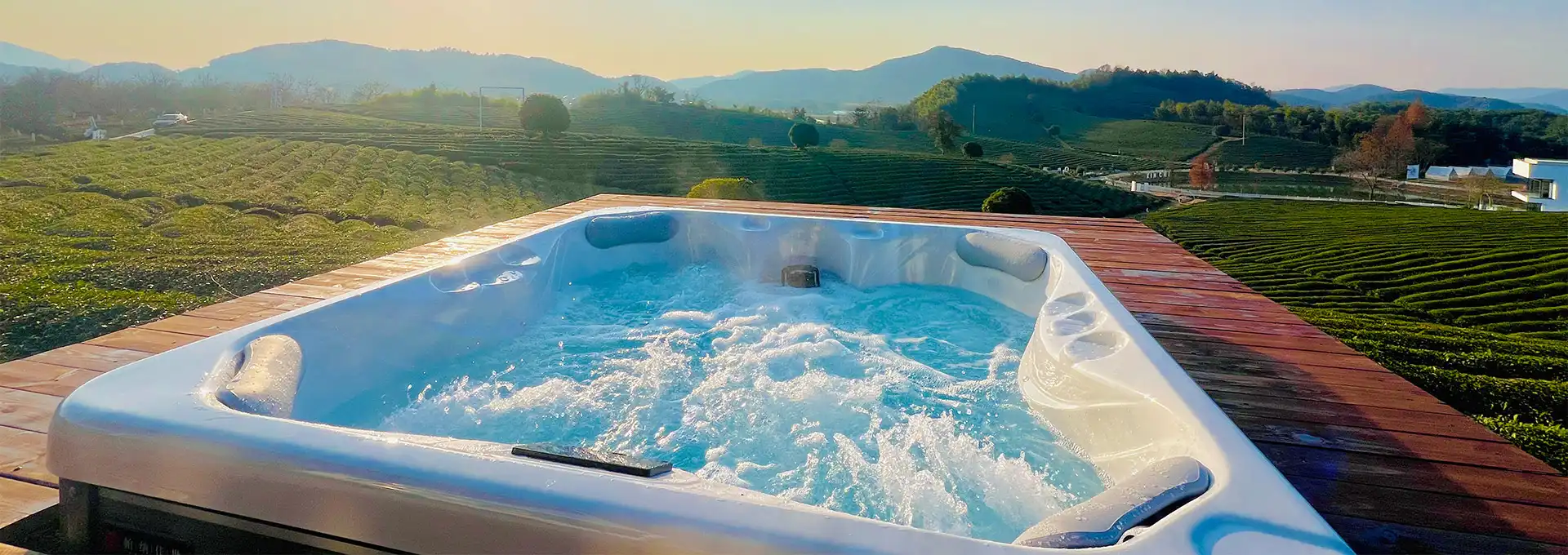Can I Place My Hot Tub on Pavers?
2024-11-16 15:53:44
Many homeowners dream of having a relaxing hot tub in their backyard, but the installation process can raise several questions. One common concern is whether it's safe and practical to place a hot tub on pavers. This article will explore the feasibility of installing a hot tub on pavers, the necessary preparations, and important considerations to ensure a successful and long-lasting setup.
What type of base is best for a hot tub?
When it comes to choosing the best base for your hot tub, several options are available, each with its own set of advantages and considerations. The ideal base should provide a stable, level, and durable surface that can support the weight of the hot tub, water, and occupants. Let's explore some of the most common and effective base options for hot tubs:
- Concrete slab: A concrete slab is often considered the gold standard for hot tub bases. It offers excellent stability, durability, and load-bearing capacity. A properly installed concrete slab can easily support the weight of even the largest hot tubs and provides a perfectly level surface. However, pouring a concrete slab requires more time, effort, and expense compared to other options.
- Pavers: Pavers are a popular choice for hot tub bases due to their aesthetic appeal and versatility. They come in various colors, shapes, and sizes, allowing you to create a custom look that complements your outdoor space. Pavers can be an excellent option for hot tub installation, provided they are properly installed on a compacted base and leveled correctly.
- Gravel or crushed stone: A well-compacted gravel or crushed stone base can be a cost-effective and practical option for hot tub installation. This type of base offers good drainage and can be easily leveled. However, it's crucial to ensure proper compaction and use a thick enough layer to prevent settling over time.
- Decking: Many homeowners choose to install their hot tubs on existing or purpose-built decks. While this can create an attractive and integrated look, it's essential to ensure that the deck is structurally capable of supporting the weight of the hot tub. Consulting with a structural engineer or experienced deck builder is recommended when considering this option.
- Spa pad: Prefabricated spa pads are specially designed for hot tub installation. These pads are typically made of high-density plastic or composite materials and offer a quick and easy installation process. They provide good weight distribution and can be placed on various surfaces, including grass, gravel, or concrete.
When selecting the best base for your hot tub, consider factors such as the weight of your specific hot tub model, local building codes, soil conditions, and your budget. Regardless of the base type you choose, ensuring proper drainage and a level surface is crucial for the longevity and performance of your hot tub.
How thick should a concrete slab be for a hot tub?
When it comes to installing a hot tub on a concrete slab, the thickness of the slab is a critical factor in ensuring the stability and longevity of your installation. The appropriate thickness of a concrete slab for a hot tub depends on several factors, including the size and weight of the hot tub, local building codes, and soil conditions. However, there are some general guidelines that can help you determine the right thickness for your concrete slab.
Typically, a concrete slab for a hot tub should be at least 4 inches thick. This thickness is often sufficient for most residential hot tub installations, especially for smaller to medium-sized models. However, for larger hot tubs or in areas with poor soil conditions, a thicker slab may be necessary.
Here are some factors to consider when determining the appropriate thickness for your concrete slab:
- Hot tub size and weight: Larger and heavier hot tubs will require a thicker slab to distribute the weight evenly and prevent cracking or settling. For example, a large hot tub that can hold 6-8 people may require a slab thickness of 6 inches or more.
- Soil conditions: The type and stability of the soil beneath the slab can affect its required thickness. If you have loose or unstable soil, you may need a thicker slab or additional reinforcement to ensure proper support.
- Local building codes: Check with your local building department for any specific requirements regarding concrete slab thickness for hot tub installations. Some areas may have minimum thickness requirements that exceed the general recommendations.
- Climate: In areas with freezing temperatures, the concrete slab may need to be thicker to prevent frost heave. In such cases, a thickness of 6 inches or more may be recommended.
- Reinforcement: Using steel reinforcement bars (rebar) or wire mesh within the concrete slab can increase its strength and durability. This reinforcement can sometimes allow for a slightly thinner slab while still providing adequate support.
It's important to note that while a 4-inch thick slab may be sufficient in many cases, opting for a 6-inch thick slab can provide extra assurance and stability. The additional thickness can help distribute the weight more evenly and reduce the risk of cracking or settling over time.
When preparing to pour a concrete slab for your hot tub, consider the following steps:
- Excavate the area to the appropriate depth, allowing for the thickness of the slab plus a layer of gravel for drainage.
- Add a 2-4 inch layer of gravel and compact it thoroughly.
- Install a moisture barrier to prevent water from seeping up through the concrete.
- Place reinforcement (rebar or wire mesh) according to local building codes and best practices.
- Pour the concrete to the desired thickness, ensuring it's level across the entire surface.
- Allow the concrete to cure fully before installing the hot tub (typically 28 days for maximum strength).
While it's possible to DIY a concrete slab for a hot tub, considering the importance of proper installation and the potential consequences of errors, it's often advisable to consult with or hire a professional concrete contractor. They can ensure that the slab is properly designed, reinforced, and installed to support your specific hot tub model and meet local building requirements.
Do I need planning permission for a hot tub?
The question of whether you need planning permission for a hot tub is a common concern for many homeowners. The answer can vary depending on your location, the specifics of your property, and local regulations. In general, most residential hot tub installations do not require planning permission, but there are exceptions and considerations to keep in mind.
Here's a breakdown of the factors that may influence whether you need planning permission for your hot tub:
- Location: The placement of your hot tub can affect whether you need planning permission. In most cases, installing a hot tub in your backyard or on an existing patio or deck doesn't require permission. However, if you're planning to place it in the front yard or in a visible location from the street, you may need to check with local authorities.
- Property type: If you live in a listed building or a conservation area, you may need to obtain permission before installing a hot tub, even in your backyard. These areas often have stricter regulations to preserve their historical or architectural significance.
- Size and permanence: Most portable hot tubs that aren't permanently fixed to the ground are considered temporary structures and typically don't require planning permission. However, larger, built-in hot tubs or those that involve significant landscaping changes might need approval.
- Privacy and noise considerations: While not directly related to planning permission, it's important to consider the impact of your hot tub on neighbors. Some local authorities may have regulations regarding privacy screens or noise levels, especially if your hot tub is close to property boundaries.
- Electrical installations: While the hot tub itself may not require planning permission, the electrical work needed to power it might. You may need to obtain electrical permits and have the work inspected by a certified electrician.
- Building regulations: Even if you don't need planning permission, your hot tub installation may still need to comply with building regulations. These can include requirements for structural support (if installed on a deck), electrical safety, and drainage considerations.
- Homeowners' associations: If you live in a community governed by a homeowners' association (HOA), you may need to obtain approval from the association before installing a hot tub, regardless of local planning requirements.
To ensure you're complying with all necessary regulations, consider taking the following steps before installing your hot tub:
- Check with your local planning department: Contact your local council or planning department to inquire about any specific requirements or restrictions for hot tub installations in your area.
- Review your property deed: Some properties may have covenants or restrictions that could affect your ability to install a hot tub.
- Consult with neighbors: While not a legal requirement, discussing your plans with neighbors can help prevent potential conflicts and ensure good relationships.
- Obtain necessary permits: Even if planning permission isn't required, you may need permits for electrical work or other aspects of the installation.
- Consider professional installation: Hiring a professional hot tub installer can help ensure that all local regulations and safety standards are met.
It's important to note that while many hot tub installations don't require planning permission, it's always better to check with local authorities before proceeding. Failing to obtain necessary permissions or comply with regulations could result in fines or the need to remove or modify your installation.
In conclusion, while planning permission is not typically required for most residential hot tub installations, it's crucial to do your due diligence. By checking local regulations, considering the specific characteristics of your property, and obtaining any necessary permits, you can ensure a smooth and compliant hot tub installation process. This approach will allow you to enjoy your new hot tub with peace of mind, knowing that you've adhered to all relevant guidelines and regulations.
For more information on hot tub installations and our products, please feel free to contact us at info@iparnassus.com.
References
- Hot Tub University. (2021). Hot Tub Installation Guide.
- Smith, J. (2020). Outdoor Living Spaces: Design and Planning. Home & Garden Press.
- Johnson, A. (2019). The Complete Guide to Hot Tub Maintenance. Spa Enthusiast Publications.
- Brown, M. (2018). Building Regulations for Residential Properties. Construction Standards Institute.
- Thompson, L. (2021). Landscaping with Water Features. Outdoor Design Magazine.
- Davis, R. (2020). Electrical Safety for Outdoor Installations. Electrical Contractors Association.
- Wilson, K. (2019). Concrete Foundations: Best Practices. Building Science Journal.
- Taylor, S. (2021). Understanding Local Planning Permissions. Urban Development Review.
- Harris, P. (2018). Hot Tub Energy Efficiency Guide. Energy Savings Institute.
- Roberts, E. (2020). Noise Reduction Strategies for Outdoor Living Spaces. Acoustic Design Quarterly.
Send Inquiry
Related Industry Knowledge
- Can You Go in a Hot Tub with Poison Ivy?
- How Do You Power a Hot Tub?
- How to Increase pH in Hot Tub?
- Is a Swim Spa Considered a Pool?
- How Big Should a Concrete Pad Be for a 6 Person Swim Spa?
- What's the Difference Between Jacuzzis, Hot Tubs, and Spas
- Do Hot Tubs Cause Heart Attacks?
- What Chemicals are in a Hot Tub?
- Can i Drain Hot Tub in Winter?
- How Do I Choose the Right Outdoor Swimming Spa Cover or Barrier to Comply With Safety Regulations?



